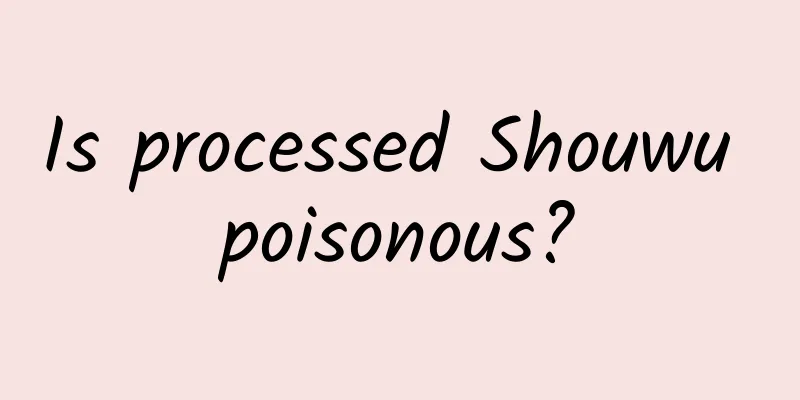Is processed Shouwu poisonous?

|
Because many people have experienced some side effects when taking processed Shouwu, and even endangered their lives, many people think that processed Shouwu is poisonous, otherwise it would not have such toxic effects. The most common toxic effects are dizziness, tinnitus, and numbness of the limbs. But is processed Shouwu, a famous Chinese medicinal material, really poisonous? It is non-toxic. Polygonum multiflorum is a perennial twining vine of the Polygonaceae family. The roots are slender, ending in a large tuber, and are reddish brown to dark brown in appearance. The Chinese medicine Polygonum multiflorum can be divided into raw Polygonum multiflorum and processed Polygonum multiflorum: the raw Polygonum multiflorum has the functions of detoxification (malaria), moistening the intestines and promoting bowel movements, and eliminating carbuncles; the processed Polygonum multiflorum has the functions of replenishing essence and blood, blackening hair, strengthening tendons and bones, and nourishing the liver and kidneys. The effects and functions of processed Polygonum multiflorum: Processed Polygonum multiflorum can nourish the liver and kidneys, improve essence and blood, blacken hair, and strengthen tendons and bones. It is used for chlorosis due to blood deficiency, dizziness and tinnitus, premature graying of hair, soreness of waist and knees, numbness of limbs, metrorrhagia and leukorrhea, physical weakness due to long-term malaria, and hyperlipidemia. Processed Polygonum multiflorum generally refers to the processed products of Polygonum multiflorum, which have a dark brown or tan surface and are uneven. The texture is hard, the cross-section surface is horny, the color is brown or black, the odor is slight, and the taste is slightly sweet and bitter. It is an essential Chinese medicinal material for treating gray hair. The English name of processed Polygonum multiflorum: RADIX POLYGONI MULTIFLORI PREPARATA. The appearance of processed Polygonum multiflorum sold in pharmacies is generally irregular wrinkled pieces, about 1 cm thick. The effects and functions of processed Polygonum multiflorum: The effects of processed Polygonum multiflorum: Processed Polygonum multiflorum can nourish the liver and kidneys, benefit the essence and blood, blacken the hair, and strengthen the tendons and bones. It is used for chlorosis due to blood deficiency, dizziness and tinnitus, premature graying of hair, soreness of waist and knees, numbness of limbs, metrorrhagia and leukorrhea, physical weakness due to long-term malaria, and hyperlipidemia. The Chinese medicine Polygonum multiflorum can be divided into raw Polygonum multiflorum and processed Polygonum multiflorum. The raw Polygonum multiflorum is cut directly into slices and used as medicine, while the processed Polygonum multiflorum is boiled with black beans, steamed, dried and used as medicine. The functions of the two are different: the raw Polygonum multiflorum can detoxify, eliminate carbuncle, moisten the intestines and relieve constipation, and is often used to treat scrofula, carbuncle, urticaria, itching, and constipation caused by dry intestines; the processed Polygonum multiflorum can nourish the liver and kidney, improve the essence and blood, blacken the hair, and strengthen the tendons and bones. It is used for blood deficiency, sallow complexion, dizziness, tinnitus, premature graying of hair, soreness of waist and knees, numbness of limbs, metrorrhagia, leukorrhea, and physical weakness caused by long-term malaria. The above article introduces whether processed Polygonum multiflorum is poisonous. In fact, processed Polygonum multiflorum itself is not toxic. Such an effect occurs due to improper use by people. No matter what kind of medicinal material it is, there will be certain side effects, and it cannot be taken as a nutritional supplement for a long time. |
<<: What are the effects of roasted Shouwu
>>: What are the effects and functions of processed Shouwu
Recommend
The temperature is like a roller coaster when the seasons change. If you don’t want to get sick, learn these things from me
With the change of seasons, the temperature often...
The efficacy and function of wild indigo
Everyone is familiar with wild indigo, but some p...
Chinese scientists discover new cell type, plants can move now!
The world we live in is colorful because of the e...
Google: Southeast Asia e-commerce report 2023
Google released the "2023 Southeast Asia E-c...
The efficacy and function of Sansho
Salsop is a very common Chinese medicine in our d...
This summer-friendly textile has so many uses in medicine!
Mulberry silk has a wide range of application pot...
The efficacy and function of rice and wheat noodles
Traditional Chinese medicine is a Chinese traditi...
Both are important cell resources. What are the similarities and differences between stem cells and immune cells?
There exists a human health guardian corps in our...
The efficacy and function of Weihan grass
Traditional Chinese medicine has a history of tho...
The efficacy and function of Xiao Lingdan
The Chinese medicine Xiao Ling Dan is a relativel...
The efficacy and effects of fresh ginseng
I believe everyone has heard of ginseng, and ever...
Difference between Plantain and Psyllium
Plantain refers to the full name of the wolfberry...
What Chinese medicine is there to nourish the kidney and strengthen yang?
In today's society, many men face various pre...
Parasites that cats avoid may be transformed into medical weapons by scientists
When we talk about Toxoplasma, we tend to think o...
The whiter the rice and flour, the better? Can eating whole grains lower blood sugar? Pay attention to three points when eating whole grains to be healthier
Author: Zhang Yu, researcher at the Chinese Cente...









